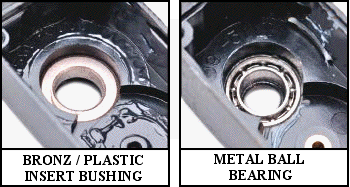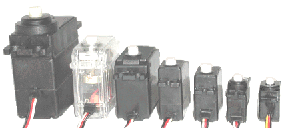
[ Back ]

|
Additional Servo Information |
||
| WHAT IS Servo Torque oz. - in |
Servos have a certain amount of torque (strength)
that is generally proportional to their size. Servos come in all kinds of sizes, strengths and weight. Torque is the measurement of force given over a distance. For most servos in the USA, torque is measured in oz-in (force in ounces times inches, or ounce-inch). Servo Torque is measured by the amount of weight (in ounces) that a servo can hold at 1-inch out on the servo output arm in the horizontal plane, again at either 4.8 or 6.0 volts to see when the servo stalls as it tries to lift the weight horizontally. The reported result is a measurement something like this: Servo XYZ = 100 oz/in. @ 6.0 V. That means that Servo XYZ is capable of holding 100 ounces using a 1 inch output arm without excessive deflection at 6.0 input volts To convert oz-in to kilogram-centimeters (kg-cm) just divide by 13.9. |
|
WHAT IS Servo Speed |
Servo Speed is measured by the amount of time (in seconds) it takes a 1 inch servo arm to sweep left or right through a 60 degree arc at either 4.8 or 6.0 volts. A servo rated at 0.22 seconds/60 degrees takes 0.22 seconds to sweep through a 60 degree arc. Some of the fastest servos available move in the 0.06 to 0.09 second range. In some servos, faster speeds may lower torque available. |
|
How are Servos Rated |
The most common details available on a servo are its speed and torque rating. Nearly all servo packages are listed with brand name, model name / number, speed, and torque output at 4.8 volts and 6.0 volts. Some information about metal, plastic gears or ball bearings may also be listed. |
|
WHAT IS Ball Bearing - vs - Plastic Bushing |
 |
|
WHAT IS Metal Gear - vs - Plastic Gear |
 |
|
WHAT IS 4.5 to 6.0 Voltage |
Servo operate at either 4.5 or 6.0 volts DC. At the higher voltage servos tend to be faster and sometimes stronger, but can heat up faster when stalled or in a hold position with stress forces against the servo output shaft. Some servo controllers require a separate power source from the control source to deliver the higher 6.0 Vdc. Servos operate from 4.8 Vdc to 6.5 Vdc. The current drain (Amps required) depends on the torque being put out by the servo motor, and can be in excess of one amp if the servo is stalled under load. It is best to calculate 1 Amp per servo when figuring power supply needs for most servos. |
|
|
WHAT TYPES of servos are available Servo Functions |
Standard Servo. Linear Servo. Low Profile Servo Slim Wing Servo Modified Continuous Rotation Servo. Winch Servo. Giant Scale Servo Monster Servos / Heavy Duty. Modified Gear Head Motor Servo. High Speed Servo Retract Servo Digital Servo |
|
|
WHAT SIZES of servos are available |
 |
|
|
|
||
[ Top of Page ]
Copyright © 2014 Blue Point Engineering, LLC , All Rights Reserved